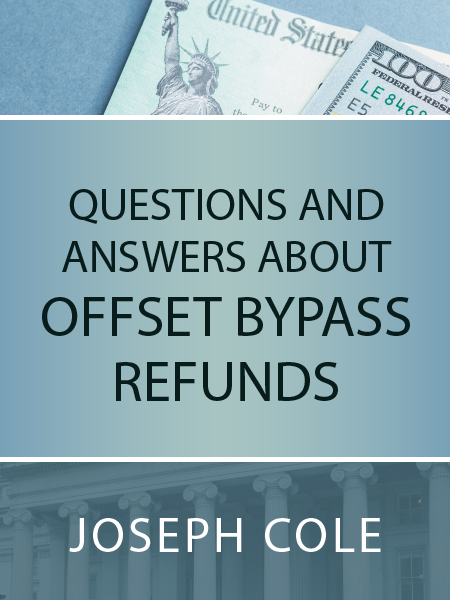If a taxpayer has delinquent tax debts, the taxpayer will generally not receive any tax return refunds due to him.1 The IRS will typically apply whatever refund that taxpayer is owed to a prior year’s tax debt. For example, if a taxpayer has a $5,000 balance owed for her 2018 Form 1040 taxes and she is due a $3,000 refund upon filing her 2021 Form 1040 return, the IRS will apply her $3,000 tax refund to the 2018 Form 1040 balance. However, the Offset Bypass Refund (OBR) is available in certain circumstances and allows a taxpayer to keep her tax refund. This article will discuss when a taxpayer qualifies for an OBR including Hardship OBRs as well as the new rules for OBRs related to Offers in Compromise (OICs).
When taxpayers qualify for OBRs

Taxpayers may qualify for OBRs when there are “hardship circumstances.”2 OBRs may not be available if a taxpayer has other debts subject to the treasury offset program like child support obligations and state tax balances.3 The IRS recently updated its procedures to allow taxpayers with pending or accepted OICs to request OBRs.4 OBRs are not available once a tax is assessed unless the IRS makes a clerical error.5 Assessment typically happens within weeks or even days of a return filing. OBRs may also be available if there is a subsequent adjustment to be made to a taxpayer’s module like an amended return posting, an adjustment from an exam, or a credit transfer.6
Hardship OBRs
Taxpayers experiencing a hardship may be eligible for an OBR.7 The hardship standard is defined by Internal Revenue Code (Code) section 6343.8 The amount of the OBR is limited to the amount necessary to alleviate the taxpayer’s hardship. For example, if a taxpayer is supposed to receive a $3,000 tax refund and needs $1,200 to avoid eviction, the taxpayer will receive a $1,200 OBR.9
Under section 6343, a hardship exists when a tax refund offset will prevent a taxpayer from paying his “reasonable basic living expenses.”10 Hardship does not exist when an OBR is necessary to maintain an “affluent or luxurious” lifestyle.11
The section 6343 standard considers factors like the number of dependents the taxpayer has, the taxpayer’s age, and the cost of living in the taxpayer’s locale.12 Section 6343 considers reasonably necessary expenses for food, clothing, housing, medical care, court-ordered payments, and expenses needed for the production of income like union dues.13 IRS Collection Standards serve as a yardstick as to what expenses are “reasonable.”
Question 1: The taxpayer files his 2021 return in February 2022. He is expecting a $3,500 refund from the 2021 return. His late-model luxury car will be repossessed unless he can make a $1,000 monthly payment. Does this taxpayer qualify for an OBR?
Answer: Probably not. He does not have a hardship because he has a “lavish” lifestyle. As of February 2022, IRS Collection Standards limit automobile ownership expenses to $533 per month. If we use
this as a yardstick, the $1,000 per-month luxury car payments are not “reasonable” and the taxpayer probably does not meet the hardship criteria.

CLICK HERE to read the full article, which was originally published in ALI CLE’s The Practical Tax Lawyer.
